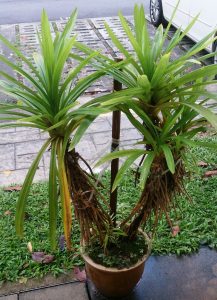 Pandanus amaryllifolius is a tropical plant in the Pandanus (screwpine) genus, which is commonly known as pandan and is used widely in South Asian and Southeast Asian cooking for flavouring.
Pandanus amaryllifolius is a tropical plant in the Pandanus (screwpine) genus, which is commonly known as pandan and is used widely in South Asian and Southeast Asian cooking for flavouring.
A. Botanical features:
The characteristic aroma of pandan is caused by the aroma compound 2-acetyl-1-pyrroline, found in the lower epidermal papillae. The compound gives white bread, jasmine rice, and basmati rice (as well as bread flowers Vallaris glabra) their typical smell. Though the plant is unknown in the wild, it is widely cultivated. It is an upright, green plant with fan-shaped sprays of long, narrow, blade-like leaves and woody aerial roots. The plant is sterile, with flowers only growing very rarely, and is propagated by cuttings.
B. Used as natural air freshener:
The leaves possess a pleasant aroma and can be used as natural air fresheners. In Thailand, taxi drivers sometimes use pandan for this purpose.
C. How to Plant Pandan
Pandan plants (Pandanus spp.) grow as 15 to 20 ft. tall trees outdoors, or as tall houseplants. Two common varieties are screw pine (Pandanus utilius), which grow in the US Department of Agriculture plant hardiness zones 10 and 11; and variegated screw pine (Pandanus tectorius “Veitchii”), which grows in USDA zones 10 through 12.
Plant pandans in late winter or early spring just before the evergreens awaken from semidormancy. Start new plants from cuttings at any time after the suckers begin to form.
D. Potted Plants
Container-grown plants require pots with bottom drainage holes to prevent the soil from staying soggy. Young plants grow well in smaller 10”-diameter containers, while more mature plants require a container deep enough to contain the roots and 2 to 4” wider in diameter than the root ball. Transplanting every 2 to 3 years before the roots become crowded leads to healthy growth. When planting or transplanting the pandan in the pot, fill one-third of the container with a standard potting soil or a soil mix formulated for tropical plants. Set the root ball on top of the soil and fill it around until the top of the root ball is just beneath the soil surface. A thorough watering after planting settles the soil around the roots.
Share with:

